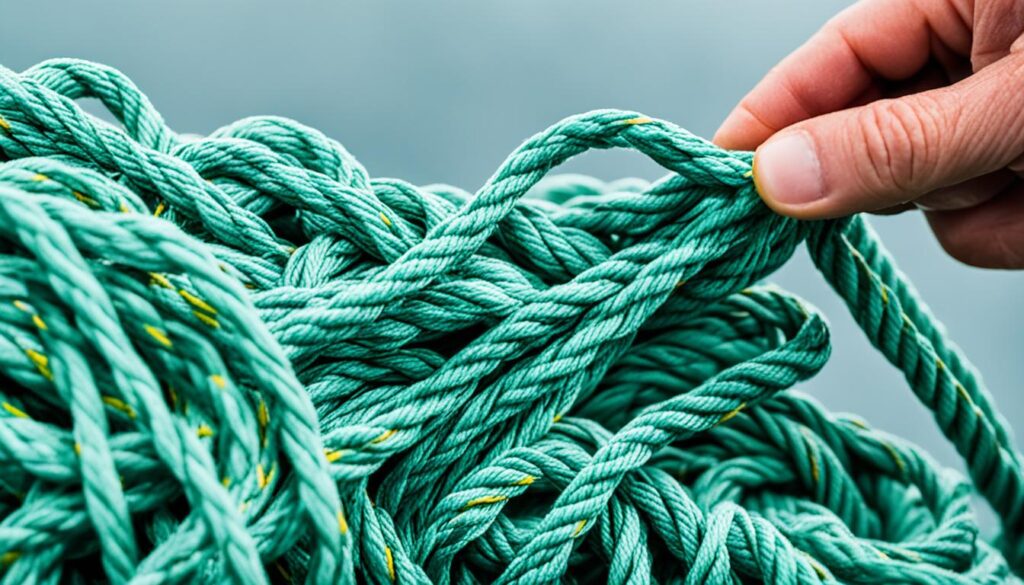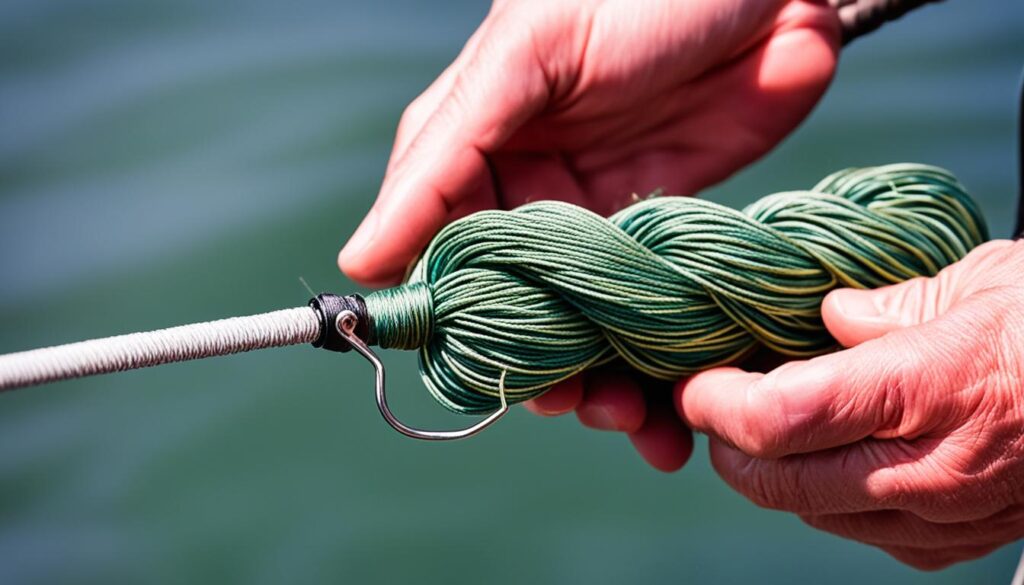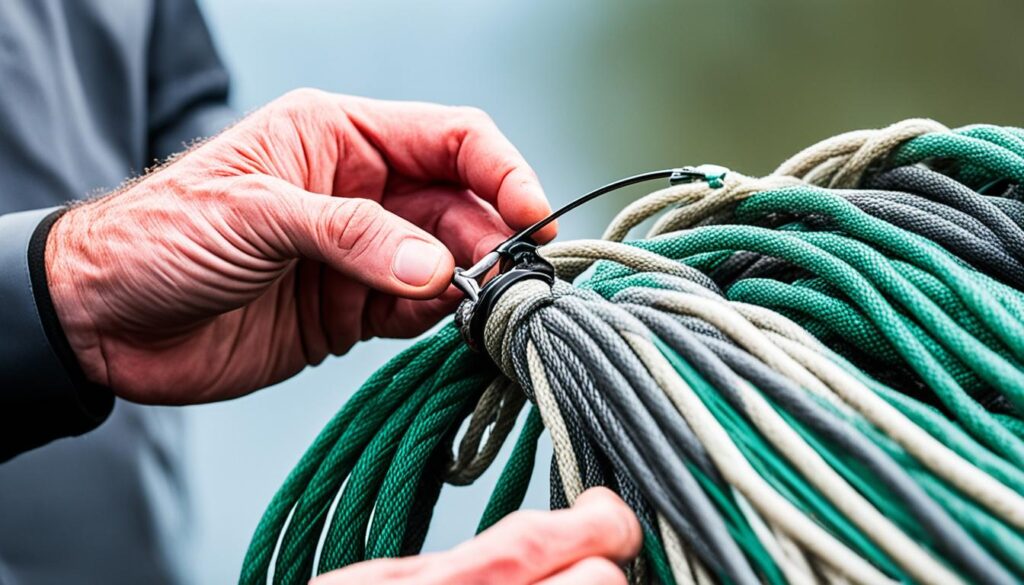It’s key to know many fishing knots. They help attach lures to lines well, each for different needs and line types. Knowing strong, reliable knots is important if you fish a lot or have just started. Even though the Snell Knot is great for flipping, there’s another you should learn.
This guide will teach you how to tie the Trilene Knot is simple to tie and strong, perfect for flipping. It’s a popular choice and works well as a Snell Knot alternative.
This tutorial teaches you to tie the Trilene Knot for flipping. We’ll guide you step by step, from picking the right line to tying the knot right. You’ll soon be a master at this essential knot.
Angler’s Essentials:
- The Trilene Knot is a reliable alternative to the Snell Knot for flipping.
- Mastering fishing knots is crucial for securing lures to lines effectively.
- The Trilene Knot is easy to tie and provides strong knot strength.
- Choosing the right fishing line is essential for successful knot tying.
- Regular practice is key to developing and maintaining knot-tying skills.
Why Are Fishing Knots Important?
Fishing knots help tie your line to a hook, lure, or swivel. They ensure your line stays put, which is key to not losing the fish you’ve caught.
Choosing the right knot for your fishing line is critical. Each type of knot works best in different situations. This decision can make or break your fishing trip.
Always use a robust and correct knot. A lousy knot can lead to losing fish and frustration, but a good, strong knot can boost your confidence while fishing.
“A well-tied knot will keep your line secure and ensure that your fish stays hooked.”
Choosing the correct knot is vital for keeping fish on the line. This applies to all types of fishing, whether you’re fishing for bass or trout. The correct knot improves your success rate.
Types of Fishing Knots
There are many useful fishing knots. Some common ones include:
- The Improved Clinch Knot: Great for lures on monofilament or fluorocarbon lines.
- The Palomar Knot: Known for its strength with monofilament lines.
- The Uni Knot: It’s versatile and works with various line types.
Knowing these knots helps you pick the best one for your fishing, increasing your chances of catching fish.
Importance of Using the Right Knot
Choosing the right fishing knot is not just about keeping the line tight. It’s also about avoiding twists and breaks. Every knot handles the line’s stress differently, which makes your setup stronger overall.
The right knot also means better casting. It moves the energy from your line to the bait or lure better, leading to longer, more accurate throws.
Your fishing’s success relies on strong knots. Learn to tie them well to keep your lines secure. This gives you a better shot at that big catch every time.
| Knot | Strength | Versatility | Line Types |
|---|---|---|---|
| Improved Clinch Knot | High | Versatile | Monofilament, Fluorocarbon |
| Palomar Knot | Excellent | Simple | Monofilament |
| Uni Knot | Reliable | Adaptable | All Types |
What Supplies Will You Need?
First, let’s talk about getting the right items for fishing. You’ll need a fishing rod and reel. Also, pick the right fishing line for the fish you want to catch. Make sure to have scissors or a knife to cut the line. And don’t forget, a bit of patience is important too. Getting good at tying knots takes practice.
Essential Fishing Supplies:
| Item | Description |
|---|---|
| Fishing Rod and Reel | A high-quality fishing rod and reel are essential for a successful fishing experience. Select a rod and reel that suit your fishing style and target fish species. |
| Appropriate Fishing Line | Choose a fishing line that matches the type of fish you are targeting and the fishing conditions. Monofilament, fluorocarbon, and braided lines each have their advantages and are suitable for different situations. |
| Scissors or Knife | Having a pair of sharp scissors or a knife on hand is essential for cutting the fishing line to the desired length and for trimming any excess line. |
| Practicing Knot-Tying Skills | Regular practice is important for developing and maintaining knot-tying skills. Use larger materials, such as thick ropes and large hooks, to practice before moving on to actual fishing lines. |
Setting up with the right gear and knot skills is a path to fishing success. You’ll be prepared for any fishing adventure with the correct tools and training.
Popular Fishing Knots and Their Uses
Knowing the right knot for your fishing line is key. Here, we’ll look at some top knots and how to use them.
Improved Clinch Knot
The Improved Clinch Knot is all about flexibility. It’s great for attaching lures to mono or fluoro lines. Anglers love it for its simplicity and trust.
Palomar Knot
The Palomar Knot is known for its strength and ease of use. It’s perfect for mono lines. Even under immense pressure, it stays strong.
Uni Knot
The Uni Knot is praised for its flexibility. It’s good with many line types and offers great strength. Plus, it’s simple to tie.
Berkley Braid Knot
The Berkley Braid Knot is the go-to for braided lines. It gives top strength and won’t slip. This keeps your line and tackle together tight.
“Choosing the right fishing knot for the situation is crucial to ensuring a successful and enjoyable fishing experience.”
– Expert Angler
Each knot has its special use. Learning them helps you be ready for any fishing challenge. And that can lead to more fishing fun and success.

| Fishing Knot | Main Uses |
|---|---|
| Improved Clinch Knot | Securing lures to monofilament or fluorocarbon lines |
| Palomar Knot | Strength and simplicity; works well with monofilament lines |
| Uni Knot | Adaptability; suitable for different line types |
| Berkley Braid Knot | Designed for braided lines; offers high strength and minimal slippage |
How to Tie a Fishing Knot
Tying a fishing knot is key for fishing. The Palomar Knot is a great choice. Here’s how you do it:
- Step 1: Double your line and thread it through the hook or lure’s eye.
- Step 2: Make a basic knot over the eye, keeping a loop at the top.
- Step 3: Hold the loop and bring it completely over the lure or hook. It now covers the lure or hook.
- Step 4: Dampen the line, then pull both sides to tighten the knot.
Getting the line wet prevents friction, which causes heat that could weaken the knot. It also prevents the line from tearing, lengthening the knot’s life.

Keep practicing the Palomar Knot. When you tighten it, always moisten the line for better outcomes.
Practice Tips and Techniques
Want to be great at tying fishing knots? There are tricks and techniques to boost your skills. Whether you’re new or just want to get better, these tips will help you become a knot-tying pro.
Start with Larger Materials
Begin by using bigger items like thick rope and a large hook. This lets you clearly see the knot’s structure. It helps you learn how to form knots right. Starting big also lays a strong knot-tying foundation for when you switch to fishing line and tackle later.
Utilize Visual Aids
Visual aids are gold for learning new knots. Use step-by-step guides, videos, and tutorials. They offer clear steps and images that show you how to tie each knot. Make the most of these tools to level up your skills.
Consistent Practice
Regular practice is crucial for knot mastery. Make knot-tying a part of your weekly routine. Do it year-round, not just when fishing season is on. With regular practice, you’ll get faster and more confident at tying knots. This is because you’ll build memory in your muscles.
Stick to these tips and you’ll ace fishing knots. Always start with big materials and use visuals for help. Keep practicing regularly to keep your knot-tying skills sharp. With dedication, you’ll be tying strong and secure knots for better fishing.
Troubleshooting Common Knot Issues
Problems with knots are normal when you’re starting out. Luckily, fixing them is easy. There are simple steps to take that can help you beat these challenges.
Using the Right Knot for the Line Type
Knots often fail if you pick the wrong one for your fishing line. Each knot works best with certain materials and when used in certain ways. It’s important to always pick the right knot. Do your research to find out which knot is best for your line and fishing situation.
Lubricating the Line to Prevent Friction Damage
Friction from tying can cause knots to be weak and fail. To stop this, you should lubricate the line before you tighten the knot. You can use water, saliva, or a silicone-based product to make tying smoother. Wet the line a bit before you secure the knot. This will make the knot stronger.
Ensuring Neat Turns before Tightening
Making your knot tidy is key to its strength and lasting power. It’s critical to check that your loops and turns are in order before you finally tighten the knot. Doing this ensures that the stress on the knot is spread out equally. Spend a little extra time to lay out your turns correctly. It’ll mean a better, safer knot that’s less likely to fail.
If you follow these steps, you’ll have less trouble with your knots. Remember to choose the correct knot, lubricate the line, and make your turns neat before tying. Practice well and pay attention to details. You’ll soon be great at tying fishing knots that hold tight.
Conclusion
Learning how to tie fishing knots is crucial for every fisher. It’s essential to tie lures tightly for better fishing. Practice makes perfect when it comes to knots and lines. Spend time getting good at it, and tying knots will be easy.
Picking the right knot is a must. Different knots work well in various situations. Knowing when and how to use them is key to catching more fish. Also, take care of your hooks to keep them sharp. This helps prevent losing any big fish you catch.
With enough practice and patience, anyone can become a knot expert. Make time to practice often and try out new knots and lines. This will boost your fishing skills and confidence out on the water, preparing you for all fishing trips ahead.
FAQ
What is an alternative to the Snell knot for flipping?
you can use alternative for flipping Trilene Knot as a Snell knot al.
What are the best fishing knots?
The top fishing knots include the Improved Clinch Knot, Palomar Knot, and Uni Knot.
How do you tie a fishing knot?
Follow these steps to tie a fishing knot: [insert instructions for tying a fishing knot]
What fishing knot techniques are easy to learn?
Beginners find the Improved Clinch Knot, Palomar Knot, and Uni Knot simple to master.
Which fishing knot is the strongest?
While strengths differ, many anglers trust the Berkley Braid Knot for its power and security.
How do fishing knots compare to each other?
Every fishing knot serves a unique purpose, designed for specific fishing situations and line materials.
Why are fishing knots important?
Strong fishing knots keep the line and hook secure, improving fishing chances and preventing lost catches.
What supplies do I need for fishing?
To start fishing, gather a rod, reel, suitable line, cutting tool for the line, and learn to tie knots.
What are some popular fishing knots and their uses?
Key fishing knots include the Improved Clinch for its versatility, the Palomar for its strength, and the Uni for its adaptability.
How do I tie a fishing knot?
Begin knot tying by learning a basic like the Palomar Knot with clear instructions.
How can I practice tying fishing knots?
Practice first with thick rope and large hooks. Then, use real fishing gear. Guides and videos also help.
What are some common issues with tying fishing knots?
Common mistakes are picking the wrong knot for your line, not shaping the knot properly, and causing friction damage.
How can I troubleshoot common knot issues?
Troubleshooting requires choosing the right knot, lubricating the line, and making sure your knots are neat.
How important is mastering fishing knots?
Knowing fishing knots well is vital for successful angling. Practice and knowing your knots are the right path to expertise.
